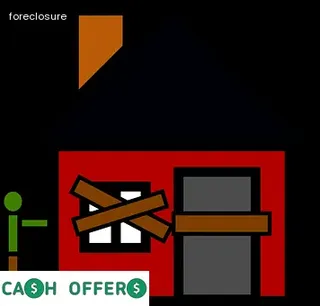California foreclosure processes and timelines can be complicated and difficult to understand. That's why it's important to have a comprehensive guide to help navigate the process.
The first step in the California foreclosure timeline is for a lender to file a Notice of Default (NOD) with the county recorder, which initiates the legal process of foreclosure. Following this, lenders must then publish a Notice of Sale (NOS) in a local newspaper or other designated publication at least 21 days prior to the sale.
This notice is a public announcement that details when and where the sale will take place, as well as any additional information related to the property being foreclosed upon. After this, lenders must wait at least 21 days before they can conduct an auction of the property.
If no bids are received during this time, lenders may proceed with obtaining ownership of the home through what is known as a trustee's deed upon sale. Finally, once all foreclosure proceedings have been completed and all back payments have been paid off, borrowers will be required to vacate their home within three months unless they reach an agreement with their lender regarding continued occupancy arrangements.
It is important to note that while each stage has its own timeline associated with it, these timelines may vary depending on individual circumstances.

Knowing the foreclosure process in California is essential for anyone who is facing financial hardship and considering this option. It can be a complex and time-consuming endeavor, but understanding the terms and timelines of the process can help you make informed decisions.
Foreclosure in California begins when a borrower fails to make mortgage payments, prompting their lender to initiate legal action. The lender will then file a Notice of Default with the county recorder's office, which gives the borrower 90 days to cure their debt or face foreclosure proceedings.
If no resolution is reached within these 90 days, the lender may proceed with filing a Notice of Sale with the county recorder's office and setting an auction date for prospective buyers. The successful bidder at this auction will assume ownership of the property and any outstanding liens on it.
After that, the borrower has five business days to redeem their loan by paying off all owed amounts plus interest and fees; otherwise they will be evicted from the property. Knowing these details when navigating California’s foreclosure process is crucial—it is possible to avoid eviction if you are prepared and take steps early on to remedy your debt situation.
The timeline for a California foreclosure can vary greatly depending on the type of loan and the particular circumstances. Generally, the process begins with a Notice of Default (NOD) being sent to the borrower by the lender when payments are not made on time.
The NOD will indicate how many payments have been missed and the amount due to bring the loan current. During this period, which is typically 90 days, it is possible for borrowers to reinstate their loans by paying all past due amounts in full.
If payment is not received by this time, then the lender will record a Notice of Trustee Sale (NOTS), which marks the start of the foreclosure process and sets an auction date for selling off property. Prior to this date, lenders may offer a short sale or deed-in-lieu of foreclosure option as an alternative to foreclosure.
On the day of sale, if no one bids higher than what is owed on the mortgage loan then it becomes a bank repossession and ownership reverts back to the lender who can then resell it or keep it as an asset. Borrowers should consult with legal counsel throughout any stage of foreclosure proceedings as laws may vary from county to county and help navigate through this difficult process.

The preforeclosure process in California begins with the filing of a Notice of Default, which is issued by the mortgage lender to inform the borrower that they are in default on their loan. This document outlines the amount due and any additional fees or costs associated with foreclosure.
Next, the lender will record a Notice of Sale, which officially initiates the foreclosure process and sets a sale date for the property. The borrower then has three months to catch up on payments and avoid foreclosure.
During this period known as "the redemption period", homeowners can obtain a loan modification or refinance their mortgage to pay off their debt. If no action is taken within this timeframe, the lender can conduct a public auction at which point ownership of the property transfers from the homeowner to the highest bidder.
It is important to understand all aspects of California foreclosure processes before they take effect so you can make an informed decision about how best to proceed during this difficult time.
Deficiency judgments are an important step in the California foreclosure process. They are a court-ordered obligation for borrowers to pay the remaining balance of their mortgage after the home has been sold at a foreclosure auction.
If the amount received from the sale is not enough to cover the unpaid debt, then a deficiency judgment can be issued to get back what is owed by the borrower. In California, lenders have up to one year after the foreclosure sale to file for a deficiency judgment.
The amount collected through this judgment cannot exceed what was originally owed on the loan and must take into consideration any other outstanding debts that were attached to the property such as taxes or liens. Additionally, lenders must prove that they have taken all reasonable steps possible to recoup their losses before seeking a deficiency judgment.

When facing foreclosure, it is important to be aware of potential scams. If a homeowner is facing foreclosure, they should be cautious when dealing with individuals or companies that offer to help them for a fee.
Homeowners should be aware that any company or individual that asks for a fee in exchange for foreclosure assistance may be attempting to scam them. If someone contacts you promising to stop your foreclosure if you pay them money, this is likely a scam.
Individuals who claim they can help with loan modifications or other legal services related to the foreclosure process should be verified by checking out their credentials and reviews online and researching the company’s history. Additionally, homeowners should never sign any documents without first understanding what they are signing, as well as notifying their lender of any changes in their financial situation.
Finally, homeowners should never feel pressured into signing anything, and should take the time to consider all options available before making any decisions regarding their home's foreclosure process.
Foreclosure is a difficult situation and can be financially, emotionally, and psychologically draining. However, there are strategies that Californians can use to avoid this process altogether.
One of the first steps in avoiding foreclosure is to assess your current financial situation. This includes budgeting for your expenses and creating a plan to pay off any debt or missed payments.
Additionally, homeowners should explore all loan modification options available to them as they could help reduce mortgage payments in the long run. Furthermore, if you have been unable to make payments due to an unexpected event like job loss or illness, it might also be possible to negotiate a payment plan with your lender.
Lastly, communication is key: staying in touch with your lender and being honest about the circumstances ensures that you have access to all resources necessary to avoid foreclosure.

When facing foreclosure, it's important to understand all of your options before making a decision. Investigating alternative solutions to foreclosures can help you find the best solution for your specific situation.
Before considering foreclosure, consider speaking with a housing counselor or consulting a lawyer about alternatives like loan modifications, forbearance agreements, deed-in-lieu of foreclosure, and short sale. Loan modification involves changing the terms of your mortgage such as interest rate or loan length.
A forbearance agreement allows homeowners to postpone payments on their mortgages temporarily while they get back on track financially. A deed-in-lieu of foreclosure is an agreement between a borrower and lender that allows the borrower to give up ownership of the property in exchange for debt forgiveness.
Finally, a short sale is when a lender approves a sale of the property for less than what is owed on the loan. Each option has different requirements and implications so make sure to review each one carefully before making any decisions regarding foreclosure.
Navigating foreclosure can be a daunting experience for homeowners, and many don’t realize the potential financial assistance that may be available to them. Programs from both the state and federal governments exist to help those facing foreclosure in California.
Homeowners can work with housing counselors, who are experts in these programs, to explore their options. The U.
Department of Housing and Urban Development offers several grant programs that help low-income families afford mortgage payments, while the California Housing Finance Agency provides grants and loans for first-time homebuyers in certain counties. Additionally, homeowners should also consider speaking with their lenders; many banks offer loan modification or refinancing which can reduce monthly payments and make it easier to stay current on their mortgages.
It is important to remember that there are resources available, so don’t hesitate to reach out for help if you are struggling with paying your mortgage.

Mortgage servicers and collection agencies play a critical role in the California foreclosure process. They are responsible for managing the accounts of borrowers who are behind on their mortgage payments and handling all communication with them.
Mortgage servicers will typically work with borrowers to try to find an alternate payment plan or loan modification to help them get back on track. If that fails, then the servicer may initiate foreclosure proceedings with the court.
Collection agencies will also contact borrowers to collect past due payments and try to negotiate settlements or repayment plans. It is important for borrowers to be aware of their rights and obligations when dealing with these entities so they can take necessary steps to avoid foreclosure if possible.
When considering a short sale or deed-in-lieu of foreclosure, it is important to understand how either option can affect your credit score. Despite the fact that either process is commonly utilized as an alternative to foreclosure, both have the potential to have an adverse effect on your credit score.
A short sale will typically cause a more significant drop in credit scores than a deed-in-lieu of foreclosure and the decline may last longer; however, in some cases the latter can also have a negative impact on your credit report. In order to minimize any damage to your credit score, make sure you are aware of all aspects of the California foreclosure process before entering into any agreement and understand what type of effect it may have on your future financial situation.
It is also important that any lender you work with reports your activity accurately, as this will help ensure that your credit report reflects the details accurately.

The preforeclosure stage of a California home foreclosure is an important period of time and can be confusing, so it's important to understand all of your options. One option is to explore alternatives such as loan modifications and repayment plans with your lender in order to avoid foreclosure.
Another option is to work with a housing counselor or lawyer who may be able to help you negotiate a solution with your lender. You might also consider selling the property in order to pay off the mortgage debt before the foreclosure process begins.
Refinancing and/or taking out a second mortgage are other potential solutions. It's important to remember that not all lenders will offer these solutions and some may require additional documentation or fees, so make sure you know what you're getting into before agreeing to anything.
Additionally, if any of these options fail, you run the risk of falling further behind on payments and potentially facing additional legal action by your lender. Therefore, educating yourself on all possibilities and understanding the risks involved during preforeclosure is critical for avoiding foreclosure in California.
California foreclosures can be confusing and difficult to navigate, as the process varies in different states. Common questions about California foreclosures include what happens at a foreclosure sale, how long the process takes, whether homeowners can avoid foreclosure, and if they need an attorney.
A foreclosure is initiated when a homeowner fails to make payments on their mortgage loan for several months. The lender then begins legal proceedings by filing a Notice of Default with the county recorder's office.
This document informs the homeowner that they have failed to make payments and must do so within a certain period of time or face foreclosure. If payments are not made, the lender will file a Notice of Sale with the county recorder's office which sets a date for the public auction.
Homeowners may avoid foreclosure by negotiating with their lenders or through programs such as loan modification or forbearance agreements. Additionally, some homeowners may choose to pursue bankruptcy as an alternative to foreclosure.
It is important to understand that each case is unique and individual circumstances will dictate timelines and outcomes; therefore, it is recommended that homeowners seek assistance from an attorney who specializes in California Foreclosure Law prior to making any decisions regarding their property.
In California, the amount of time a homeowner may stay in their home after foreclosure depends on several factors. Generally, the homeowner will have between 90 and 120 days to vacate the property once a Notice of Sale is filed.
However, this timeline can be shortened if the foreclosing party opts for an expedited foreclosure process. Homeowners facing foreclosure should always seek legal advice to understand their rights and options during the process.
Depending on various circumstances, there may be ways to challenge or delay the sale of a home, or even find alternatives to foreclosure such as loan modification or short sale. The comprehensive guide to California's foreclosure processes and timelines can help homeowners facing foreclosure make informed decisions about their situation.

Foreclosure is a complicated process, and California’s foreclosure timeline and processes can vary significantly. On average, the California foreclosure process takes anywhere from three to seven months.
This timeline can be affected by numerous factors such as the lender's policies and procedures, the type of loan, and local court rules. Before beginning the process, it’s important to understand what will happen during each step of the foreclosure process in California.
To help you stay on top of your situation, this comprehensive guide outlines the typical timelines involved in a foreclosure in California and the steps that must be taken. Depending on your particular situation, there are certain protections available to those facing home foreclosure in California.
Understanding how long it typically takes for a home to go through foreclosure in California is an essential first step in preparing for this challenging experience.
California's most common foreclosure process is Judicial Foreclosure. Judicial Foreclosure involves the lender filing a lawsuit in court against the homeowner for foreclosure.
This type of foreclosure is initiated when the homeowner defaults on their mortgage payments and the lender notifies them of their intent to foreclose. In California, Judicial Foreclosure must go through the local courts system.
The process begins with the lender filing a complaint in court, detailing why they are seeking foreclosure, and requesting that the court enter a judgment of foreclosure. The homeowner then has a certain amount of time to respond to this suit by filing an answer with the court.
If no response is filed, or if an answer is filed but no defense against foreclosure is presented, then the judge will enter a default judgment in favor of the lender and order a sale date for the property. After all legal proceedings have been concluded, notice must be given to all interested parties before a public auction can take place where potential buyers can bid on the property.
Yes, it is possible to stop a foreclosure in California. The best way to do this is by understanding the foreclosure process and timelines that are required by state law.
A comprehensive guide to California foreclosure processes and timelines can help homeowners understand the steps they need to take in order to avoid losing their home. By learning about the timeline for activities such as default notices, auction sales, and redemption periods, homeowners can be better prepared to take necessary actions if they are facing foreclosure.
Additionally, there are a variety of resources available to help stop a foreclosure in California, including loan modifications and refinancing options that may make repaying the mortgage more manageable. With the right information and support, it is possible for homeowners in California to stop a foreclosure and keep their home.